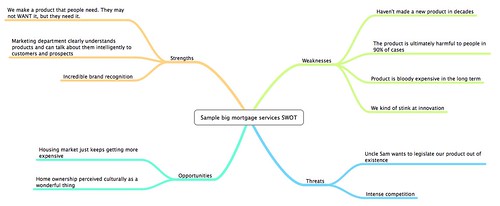- The 4 Ps of Marketing
- The SWOT Analysis
- Marketing Funnels
- Understanding Fast, Cheap, Good
- Basic methods of making money
- Basic marketing campaign plan
- Always be testing
- Marketing ROI
- Foundations of Creative Marketing
- The Marketing Spirit
For the past 40 years, strategists have used a model created by Albert Humphrey of Stanford University called SWOT to determine how achievable a business objective is. SWOT stands for Strengths, Weaknesses, Opportunities, and Threats.
SWOT is a deeper analysis than it first appears when it’s explained to you. It can be a powerful tool for understanding your business, your marketing, and your overall strategy for any given objective, whether it’s dominating Twitter in your niche or cornering the market in your industry. Let’s walk through each of the components.

It can, in fact, be done on a napkin.
First, SWOT is broken up into two categories, internal characteristics and external factors. Strengths and weaknesses are internal characteristics of your company or team that give you advantages or disadvantages. Understanding this half of SWOT alone can do wonders for your business, as it requires a great deal of mental flexibility. Any attribute of your company or team can simultaneously be both.
For example, let’s say your company is a small company. Nimbleness and agility in the marketplace are strengths, but lack of bench depth and resources are its weaknesses. Or, let’s say your company has chosen an intern to run your Twitter account. The strength of this approach is very low cost, but the weakness is that the intern probably has no idea how to manage your brand.
Internal characteristics are important because they are largely under your control. You can enhance a strength or mitigate a weakness by your choices. If you feel, for example, that a mobile strategy is an important area that is currently a weakness, you can train or hire someone with that skill set and make it a strength, an internal characteristic of your organization.
The second half of SWOT is a look at opportunities and threats. These are external factors that are probably not going to be in your control (or minimally so) and can impact your ability to achieve your objectives.
Opportunities are external events or conditions that can give you a market advantage. For example, if you banked on Foursquare becoming a dominant local marketing channel for your restaurant and became an early adopter, your investment may have paid off. If you foresaw the shift from metal to grunge in the 90s and hired new bands accordingly, you were able to seize the opportunity and profit from it. You had no control over the opportunity itself, but were able to ride the wave.
Conversely, threats are those external events or conditions that can disadvantage you. For example, the US government completely wiped out the federal student loan market a couple of years ago, making business for student loan companies extremely difficult. Craigslist has steadily depleted newspapers’ income by replacing their classified ads revenue with the free or almost-free Craigslist service.
Like strengths and weaknesses, opportunities and threats can simultaneously exist for a company. If you ran a flea market, eBay delivered a swift kick in the shorts to your business, becoming the dominant competitor in your industry and a major threat. However, it also created the opportunity for you and your vendors to sell to a global audience rather than a local audience. Instead of people looking for stuff for themselves and their houses, now flea markets are crowded with buyers and resellers who sniff out bargains and arbitrage them on eBay.
Conducting a SWOT exercise for yourself, your team, or your company is fairly straightforward. While you can do some very expensive, very complex analysis, the model equally lends itself to sitting down with a few folks, some drinks, and a few sheets of paper (or even a napkin). Let’s say you’re a social media consultant sitting down with a client. You’d divide up a sheet of paper (or run a mind map, or whatever) into four sections, then talk over each category. Here’s an example using a mind map of what a very simple SWOT might look like for a mortgage services company.
What’s often not discussed in SWOT analysis is the connection between the halves. Understanding your strengths and weaknesses is good and important, as is understanding your marketplace and competitive landscape. The next step after doing the basic analysis is to examine each opportunity and threat and determine how your strengths and weaknesses will impact each item.
For example, let’s say you’ve identified that you have outstanding customer service as a strength, but at the cost of a lack of scalability. The marketplace shows an opportunity for service-oriented companies to do well on Twitter. When you dig into your analysis to evaluate Twitter as a marketing channel, you recognize that you can capitalize on your service abilities to deliver the same great service on Twitter. However, you also recognize that as your company grows, you simply can’t scale the number of people needed to manage Twitter for your company. Now you have an idea of how your strengths and weaknesses impact this opportunity.
Another example, let’s say you’ve identified that you have great technical agility but all of your digital assets are tied up in your niche’s SEO. Maybe you make carbolic smoke balls and the government is about to outlaw your core product entirely. You understand the threat, so you need to mitigate your weakness – locking yourself into one brand and product – by diversifying and getting new web sites up and running (and ranking in search engines) very quickly.
Finally, one of the most important areas where people go wrong with SWOT analysis is confusing the internal and external. I’ve seen MBAs with wonderful degrees from top shelf business schools screw this up royally, so don’t feel bad if you don’t quite get it down on the first run. Internal are factors that you have control over. External are factors you largely don’t have control over. If you’ve mixed up the two, chances are you just need to rephrase and reframe the external as an internal factor.
For example, let’s say you think a strength of the company is a #1 keyword ranking in Google. That is clearly an external factor – if Google changes its algorithm, tomorrow you might vanish in the search engine listings. However, what got you to be #1 in Google was a team that can generate great content and solicit links from A-list bloggers to your content. That’s an internal factor, something you have control over, which in turn means it’s something you can change if the external factors change. If Google rearranges its algorithm and goes from an opportunity to a threat, you can refocus your strengths to mitigate that threat and transform it back to an opportunity.
I hope this explanation of the SWOT analysis is useful to you in your white belt marketing training. SWOT, properly used, can be an incredibly valuable tool in your marketing toolkit for making decisions, setting strategy, and evaluating courses of action.
This post is part of the Marketing White Belt series.- The 4 Ps of Marketing
- The SWOT Analysis
- Marketing Funnels
- Understanding Fast, Cheap, Good
- Basic methods of making money
- Basic marketing campaign plan
- Always be testing
- Marketing ROI
- Foundations of Creative Marketing
- The Marketing Spirit
You might also enjoy:
- Almost Timely News: Principles-Based Prompt Engineering (2024-02-25)
- Fireside Chat: Geraldine Deruiter on Food, Feminism, and Fury
- Mind Readings: Generative AI and Addition vs Substitution of Jobs
- Almost Timely News, January 7, 2024: Should You Buy a Custom GPT?
- Almost Timely News, January 28, 2024: Copyright Must NEVER Apply to AI-Made Works
Want to read more like this from Christopher Penn? Get updates here:
 Take my Generative AI for Marketers course! |



Leave a Reply